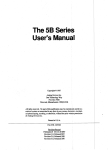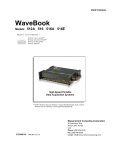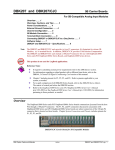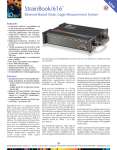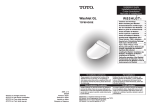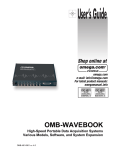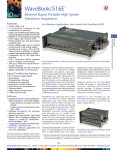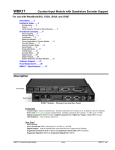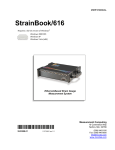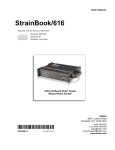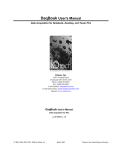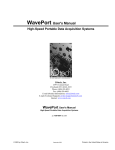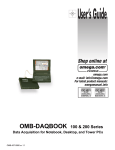Download Measurement Computing / IOtech WBK15 Manual
Transcript
Artisan Technology Group is your source for quality new and certified-used/pre-owned equipment • FAST SHIPPING AND DELIVERY • TENS OF THOUSANDS OF IN-STOCK ITEMS • EQUIPMENT DEMOS • HUNDREDS OF MANUFACTURERS SUPPORTED • LEASING/MONTHLY RENTALS • ITAR CERTIFIED SECURE ASSET SOLUTIONS SERVICE CENTER REPAIRS Experienced engineers and technicians on staff at our full-service, in-house repair center WE BUY USED EQUIPMENT Sell your excess, underutilized, and idle used equipment We also offer credit for buy-backs and trade-ins www.artisantg.com/WeBuyEquipment InstraView REMOTE INSPECTION LOOKING FOR MORE INFORMATION? Visit us on the web at www.artisantg.com for more information on price quotations, drivers, technical specifications, manuals, and documentation SM Remotely inspect equipment before purchasing with our interactive website at www.instraview.com Contact us: (888) 88-SOURCE | [email protected] | www.artisantg.com WBK15 5B Isolated Signal-Conditioning Module Description …… 1 Hardware Setup …… 2 Configuration …… 2 Connection …… 3 Power …… 4 Safety Concerns …… 4 Using Fastener Panels to Stack Modules …… 4 Software Setup …… 5 WBK15 – Specifications …… 7 Description The WBK15 module can accommodate eight 5B isolated-input signal-conditioning modules for use with the WaveBook. The WaveBook can accommodate 8 WBK15s for a maximum of 64 expansion channels. The WaveBook scans WBK15’s channels at the same 1 µs/channel rate that it scans all WBK analog inputs, allowing it to measure all channels of a fully configured 72-channel system in 72 µs. Other features of WBK15 include: • Built-in power supply that operates from 10 to 30 VDC and can power a full complement of 5B modules (even with bridge excitation). • Removable, plug-in screw-terminal blocks for convenient connection of 5B modules. • On-board cold-junction sensing for thermocouple 5B modules. • For each 5B module, 1500 V isolation from the system and from other channels. Current-Sense Resistor Input Terminal Block Channel 1 Cold Junction Sensor Internal Jumpers Buffered LowPass Filter 5B Module Socket #1 5.000 V Reference CH1 CH2 CH3 CH4 CH5 CH6 CH7 CH8 Channel Selection MUX +15 V N N Analog Output to WaveBook Control DAC Isolated +5, ±15 VDC Power Power Supply Switch +V Output MUX -15 V Filters +5 V DC Power Input & Expansion BNC Buffer Amp Channels 2-8 identical GND Bipolar Offset Amp µP & Control Logic EEPROM DIN-5 Expansion Control From WaveBook Status LEDs WBK15 Block Diagram WBK15, 5B Isolated Signal Conditioning Module 988396 Artisan Technology Group - Quality Instrumentation ... Guaranteed | (888) 88-SOURCE | www.artisantg.com WBK15, pg. 1 Hardware Setup Configuration The next figure shows the board layout within a WBK15. Note the channel-number layout for the 5B modules and the location for plug-in current-sense resistors. Only current-input type modules require the plug-in resistors. The plug-in resistors must be removed for all other module types. Rear Panel BNC DB15 DB15 DIN5 DIN5 Expansion Control Out Expansion Control In Power Out Power In BNC Expansion Expansion Signal Out Signal In ON/OFF Switch Fuse CHANNEL 1 ch 2 R10 R5 CHANNEL 2 ch 1 ch 2 CHANNEL 3 ch 4 ch 1 R16 R13 CHANNEL 5 ch 6 ch 3 R20 CHANNEL 4 ch 3 ch 4 R18 CHANNEL 7 ch 8 ch 5 CHANNEL 6 ch 5 Front Panel - signal inputs from 8 channels WBK15 Board Layout ch 6 R22 R23 ch 7 CHANNEL 8 ch 7 ch 8 Screw-terminal Signal Plug Status LEDs Installation of 5B Modules WARNING Electric shock hazard! Turn off power to WBK15 and all connected modules and devices before inserting or removing modules. Failure to do so could lead to injury or death due to electric shock. CAUTION Handle the 5B module carefully while inserting pins into the daughterboard. Do not over-tighten mounting screw. The 5B modules plug into a daughterboard (×2) on WBK15’s motherboard. Rubber bumpers on one side and a tilted daughterboard allow the module to rest at a 5° angle to facilitate insertion and removal. The adjacent daughterboard has a cut-a-way to allow room for a screwdriver (see figure). WBK15, pg. 2 988396 WBK15, 5B Isolated Signal Conditioning Module Artisan Technology Group - Quality Instrumentation ... Guaranteed | (888) 88-SOURCE | www.artisantg.com 5B Pins (×14) Screwdriver 5B Module Daughterboard Screw Receptacle 5B Module Pin (×14) Receptacles 5°angle to facilitate installation WBK15 Main Board Rubber Rest Connection 5B Module Insertion/Removal Mounting Screw WARNING Electric shock hazard! De-energize circuits connected to WBK15 before changing the wiring or configuration. Failure to do so could lead to injury or death due to electric shock. Signals are connected by screw-terminal signal plugs that plug into the 4-pin jacks on WBK15’s front panel (see figure). -EXC - + +EXC -EXC Negative excitation output - only used on strain-gage type modules - Negative signal input + Positive signal input +EXC Positive excitation output - only used on strain-gage type modules Signal Connection Jacks (per channel) Input signals (and excitation leads) must be wired to the plug-in terminal blocks. Eight 4-terminal blocks accept up to 8 inputs. Terminal blocks are connected internally to their corresponding signal conditioning module. The terminal blocks accept up to 14-gage wire into quick-connect screw terminals. Each type of input signal or transducer (such as a thermocouple or strain gage) should be wired to its terminal block as shown in the figure below. Wiring is shown for RTDs, thermocouples, 20mA circuits, mV/V connections, and for fulland half-bridge strain gages. SIG L SIG H -EXC -Vin +Vin +EXC -EXC + Thermocouple Connection _ -Vin +Vin +EXC mV and V Connection -EXC -Vin +Vin +EXC Full-Bridge Strain-Gage Connection -Vin +Vin 4-Wire +EXC -EXC -EXC -Vin AC1362 2-Wire 3-Wire +Vin +EXC RTD Connection -EXC -Vin +Vin +EXC Half-Bridge Strain-Gage Connection 4-20 mA Connection 20 Ohm Plug-In Resistor (SC-AC-1362) On-Board Socket Typical Signal Connections WBK15, 5B Isolated Signal Conditioning Module 988396 Artisan Technology Group - Quality Instrumentation ... Guaranteed | (888) 88-SOURCE | www.artisantg.com WBK15, pg. 3 Power Like the WaveBook, WBK15 contains an internal power supply. The unit can be powered by the included AC power adapter or any 10 to 30 VDC source, such as a 12 V car battery. For portable or field applications, WBK15 and the WaveBook can be powered by the DBK30A rechargeable battery module or DBK34 vehicle UPS module. The supply input is fully isolated from the measurement system. If the fuse requires replacement, it is a 2 A fuse (Littelfuse #251002). Prior to daisy-chaining from one module’s power connector to another, be sure to compute the power consumption for the entire system. Some modules may need independent power adapters. The WaveBook manual’s chapter entitled, System Setup and Power Options contains detailed information regarding power supply issues. Safety Concerns WARNING Shock Hazard! Voltages above 50 Vrms AC and voltages above 100 VDC are considered hazardous. Safety precautions are required when 5B modules are used in situations that require high-voltage isolation from the rest of the system. Failure to practice electrical safety precautions could lead to injury or death. WBK15 is specified for 1500 VDC isolation in a normal environment free from conductive pollutants and condensation. The 1500 VDC rating requires a proper earth ground connection to the chassis and treatment of adjacent inputs as potentially hazardous. CE-marked units used in the European community are rated at 600 VDC isolation. The 600 VDC CE isolation specification is based on a double insulation requirement, and no earth ground is required. Input cables must be rated for the isolation potential in use. Line voltage ratings are much lower than the DC isolation values specified due to transients that occur on power lines. Never open the lid unless all inputs with potentially hazardous voltages are removed. The lid must be securely screwed on during use. Some things to remember: • Before closing up an open WBK15, ensure no foreign objects are inside. • Properly tighten all chassis screws before system use. • Properly tighten the screw that retains the 5B module. • Never plug in or unplug potentially hazardous connections with power applied to any connected equipment. • Never attempt to change 5B modules or open the lid with power applied to the WBK15. You could short out internally exposed circuits and cause personal injury or equipment damage. Reference Note: Refer to the System Setup and Power Options chapter of the WaveBook User’s Manual for detailed information regarding the power aspects of WaveBook systems. Using Fastener Panels to Stack Modules For convenient mounting, the WBK15 has the same footprint as other WBK modules and WaveBooks. Fastener panels (splice plates) provide a means for stacking WaveBooks and modules. Screw-on handles are available for portable applications. Reference Note: For an illustration pertaining to mounting modules with fastener panels refer to the introduction of this manual. When using WBK17 modules in conjunction with other WBK modules, the WBK17 modules must be located closest to the WaveBook/516 (or /516A), due to the CA-217 cable length. The order of the other WBK modules does not matter. WBK15, pg. 4 988396 WBK15, 5B Isolated Signal Conditioning Module Artisan Technology Group - Quality Instrumentation ... Guaranteed | (888) 88-SOURCE | www.artisantg.com Fastener panels will partially block the vents on WBK16, WaveBook/516, and WaveBook/516A when stacked. This partial blocking of vents does not jeopardize the cooling process. Software Setup You will need to set several parameters so WaveView can best meet your application requirements. For detailed WaveView information, refer to the WaveView Document Module. After the 5B module type is identified, WaveView figures out the m and b (of the mx+b equation) for proper engineering units scaling. An example of the mx + b equation follows shortly. Reference Note: ➣ For detailed WaveView information, refer to the WaveView Document Module. ➣ The API does not contain functions specific to WBK15. Refer to related material in the Programmer’s Manual (p/n 1008-0901) as needed. PDF Note: During software installation, Adobe® PDF versions of user manuals automatically install onto your hard drive as a part of product support. The default location is in the Programs group, which can be accessed from the Windows Desktop. Refer to the PDF documentation for details regarding both hardware and software. Note that you can also access PDF documents directly from the data acquisition CD via the <View PDFs> button on the CD’s opening screen. WaveView Configuration Main Window mX +b, an Example The Customize Engineering Units dialog box can be accessed via the WaveView Configuration main window by activating the Units cell [for the desired channel], then clicking to select mX+b. From the Customize Engineering Units dialog box (see figure at right), you can enter values for m and b components of the equation that will be applied to the data. There is also an entry field that allows you to enter a label for the new units that may result from the mX+b calculation. An example of mX + b equation use follows. WBK15, 5B Isolated Signal Conditioning Module 988396 Artisan Technology Group - Quality Instrumentation ... Guaranteed | (888) 88-SOURCE | www.artisantg.com WBK15, pg. 5 Engineering Units Conversion Using mx + b Most of our data acquisition products allow the user to convert a raw signal input (for example, one that is in volts) to a value that is in engineering units (for example, pressure in psi). The products accomplish this by allowing the user to enter scale and offset numbers for each input channel, using the software associated with the product. Then the software uses these numbers to convert the raw signals into engineering units using the following “mx + b” equation: Engineering Units = m(Raw Signal) + b (1) The user must, however, determine the proper values of scale (m) and offset (b) for the application in question. To do the calculation, the user needs to identify two known values: (1) the raw signal values, and (2) the engineering units that correspond to the raw signal values. After this, the scale and offset parameters can be calculated by solving two equations for the two unknowns. This method is made clear by the following example. Example An engineer has a pressure transducer that produces a voltage output of 10.5 volts when the measured pressure is 3200 psi. The same transducer produces an output of 0.5 volt when the pressure is 0 psi. Knowing these facts, m and b are calculated as follows. A - Write a pair of equations, representing the two known points: 3200 = m(10.5) + b (2) 0 = m(0.5) + b (3) B - Solve for m by first subtracting each element in equation (3) from equation (2): 3200 - 0 = m(10.5 – 0.5) + (b - b) (4) Simplifying gives you: This means: m 3200 = m(10) (5) = 320 (6) C - Substitute the value for m into equation (3) to determine the value for b: 0 = 320 (0.5) + b (7) So: b = - 160 (8) Now it is possible to rewrite the general equation (1) using the specific values for m and b that we just determined: Engineering Units = 320(Raw Signal) - 160 (9) The user can then enter the values of m and b into the appropriate location using the facilities provided by compatible data acquisition software, for example: WaveView, DaqView, Personal DaqView, LogView, and TempView. The software uses equation (9) to calculate signal values in engineering units from that point on. WBK15, pg. 6 988396 WBK15, 5B Isolated Signal Conditioning Module Artisan Technology Group - Quality Instrumentation ... Guaranteed | (888) 88-SOURCE | www.artisantg.com WBK15 – Specifications Name/Function: WBK15 Multi-Purpose Isolated Signal Conditioning Module Connectors: 2 BNC connectors, mate with expansion signal input on the WaveBook/512, /512A, /516, /516A, /516E; two 15-pin connectors, mate with the WaveBook’s Expansion Signal Control Module Capacity: Eight 5B modules (optional) See latest catalog or contact your sales representative in regard to the types of 5B Modules available for your application. Input Connections: Removable 4-terminal plugs (Weidmuller type BL4, PN 12593.6, or type BLTOP4, PN 13360.6) Power Requirements: 10 to 30 VDC, or 120 VAC with included adapter With 8 thermocouple-type modules: 12 VDC @ 0.25 A, 15 VDC @ 0.20 A, 18 VDC @ 0.2 A With 8 strain-gage-type modules: 12 VDC @ 0.95 A, 15 VDC @ 0.75 A, 18 VDC @ 0.65 A Cold-Junction Sensor: Standard per channel Shunt-Resistor Socket: One per channel for current loop inputs Isolation Signal Inputs to System: 1500 VDC (600 VDC for CE compliance) Input Channel-to-Channel: 1500 VDC (600 VDC for CE compliance) Power Supply to System: 50 VDC Dimensions: 221 mm × 285 mm × 36 mm (8.5” × 11” × 1.375”) Weight: 1.8 kg (4 lb) [with no modules installed] WBK15, 5B Isolated Signal Conditioning Module 988396 Artisan Technology Group - Quality Instrumentation ... Guaranteed | (888) 88-SOURCE | www.artisantg.com WBK15, pg. 7 WBK15, pg. 8 988396 WBK15, 5B Isolated Signal Conditioning Module Artisan Technology Group - Quality Instrumentation ... Guaranteed | (888) 88-SOURCE | www.artisantg.com Artisan Technology Group is your source for quality new and certified-used/pre-owned equipment • FAST SHIPPING AND DELIVERY • TENS OF THOUSANDS OF IN-STOCK ITEMS • EQUIPMENT DEMOS • HUNDREDS OF MANUFACTURERS SUPPORTED • LEASING/MONTHLY RENTALS • ITAR CERTIFIED SECURE ASSET SOLUTIONS SERVICE CENTER REPAIRS Experienced engineers and technicians on staff at our full-service, in-house repair center WE BUY USED EQUIPMENT Sell your excess, underutilized, and idle used equipment We also offer credit for buy-backs and trade-ins www.artisantg.com/WeBuyEquipment InstraView REMOTE INSPECTION LOOKING FOR MORE INFORMATION? Visit us on the web at www.artisantg.com for more information on price quotations, drivers, technical specifications, manuals, and documentation SM Remotely inspect equipment before purchasing with our interactive website at www.instraview.com Contact us: (888) 88-SOURCE | [email protected] | www.artisantg.com










